Intel Core i7-11700K Review: Blasting Off with Rocket Lake
by Dr. Ian Cutress on March 5, 2021 4:30 PM EST- Posted in
- CPUs
- Intel
- 14nm
- Xe-LP
- Rocket Lake
- Cypress Cove
- i7-11700K
Gaming Tests: World of Tanks
Albeit different to most of the other commonly played MMO or massively multiplayer online games, World of Tanks is set in the mid-20th century and allows players to take control of a range of military based armored vehicles. World of Tanks (WoT) is developed and published by Wargaming who are based in Belarus, with the game’s soundtrack being primarily composed by Belarusian composer Sergey Khmelevsky. The game offers multiple entry points including a free-to-play element as well as allowing players to pay a fee to open up more features. One of the most interesting things about this tank based MMO is that it achieved esports status when it debuted at the World Cyber Games back in 2012.
World of Tanks enCore is a demo application for its new graphics engine penned by the Wargaming development team. Over time the new core engine has been implemented into the full game upgrading the games visuals with key elements such as improved water, flora, shadows, lighting as well as other objects such as buildings. The World of Tanks enCore demo app not only offers up insight into the impending game engine changes, but allows users to check system performance to see if the new engine runs optimally on their system. There is technically a Ray Tracing version of the enCore benchmark now available, however because it can’t be deployed standalone without the installer, we decided against using it. If that gets fixed, then we can look into it.
The benchmark tool comes with a number of presets:
- 768p Minimum, 1080p Standard, 1080p Max, 4K Max (not a preset)
The odd one out is the 4K Max preset, because the benchmark doesn’t automatically have a 4K option – to get this we edit the acceptable resolutions ini file, and then we can select 4K. The benchmark outputs its own results file, with frame times, making it very easy to parse the data needed for average and percentiles.
| AnandTech | Low Resolution Low Quality |
Medium Resolution Low Quality |
High Resolution Low Quality |
Medium Resolution Max Quality |
| Average FPS |  |
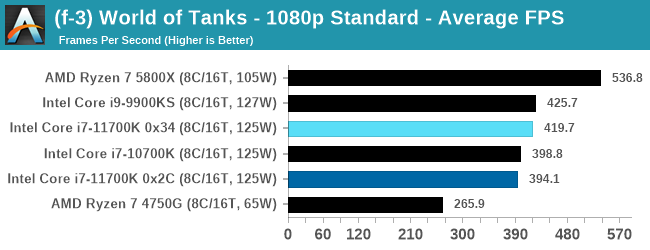 |
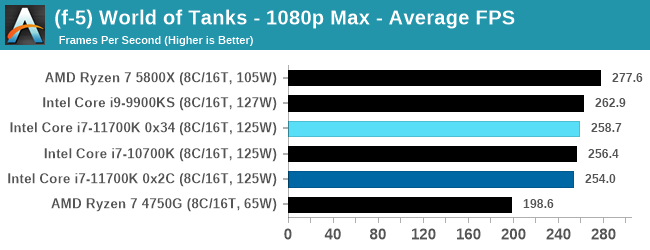 |
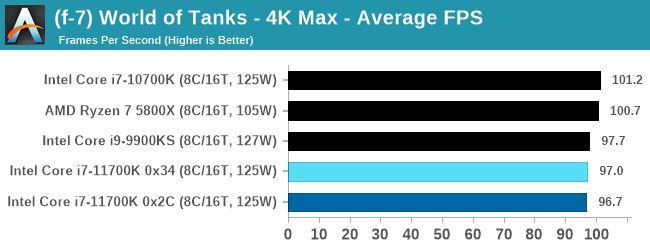 |
| 95th Percentile | 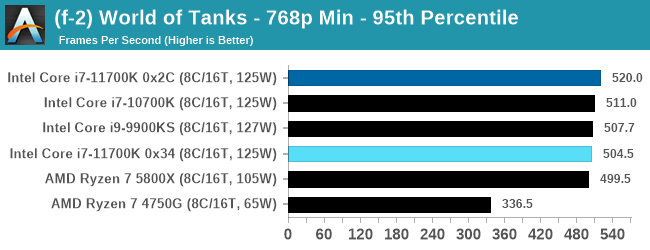 |
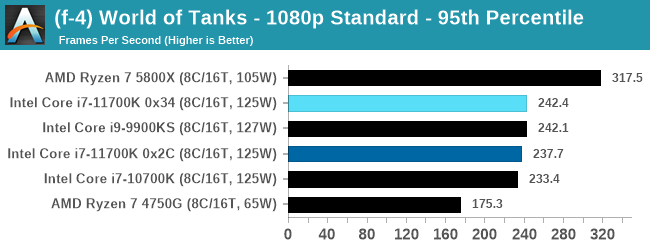 |
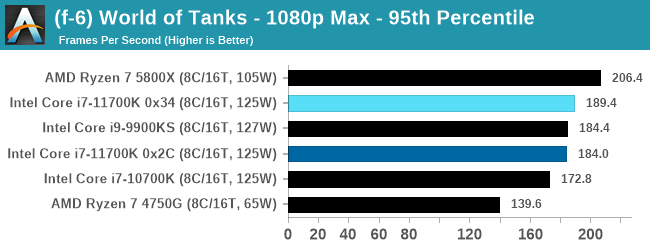 |
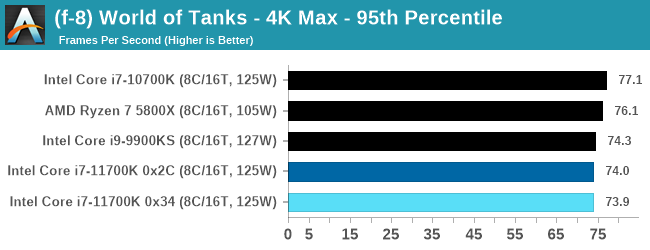 |
WoT is a fun test to see 700 FPS+ numbers with the best CPUs. However the differences between the CPUs end up being minor, and in absolute terms the 11700K still has issues, often sitting at the lower end of the results.
All of our benchmark results can also be found in our benchmark engine, Bench.


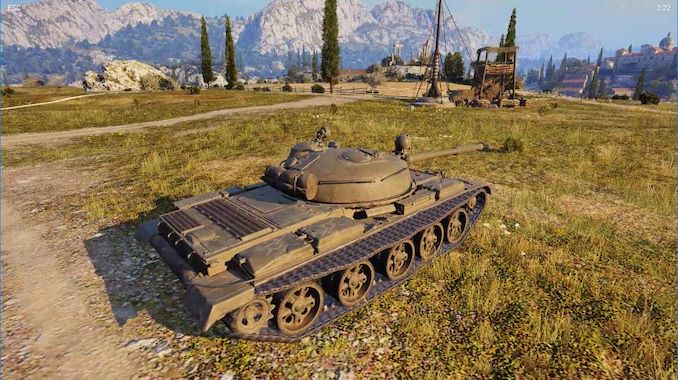









541 Comments
View All Comments
brucethemoose - Monday, March 8, 2021 - link
1: AT benches on Windows, and right now x86 vs ARM is kinda Apples-to-oranges on that platform, especially when one starts mixing in emulation and AVX.Give it time. More comparisons will come. But you'll probably see comparisons on Linux/Mac, and open source software in general, sooner.
2: People uses CPUs for different things. Some of these benches are relevant to those people.
At the same time, my use cases weren't really covered here, so... I get what you're saying.
3. Yeah, it seems rather silly to me, especially when Anand test GPU limited AAA games.
Where you really need a big CPU is in simulation/sandbox games, especially in servers for such things, and sluggish early access stuff. But no one ever benches those :/
Silver5urfer - Monday, March 8, 2021 - link
So with the 19% IPC claim and losing to 9900KS and 10700K what is the point of releasing this chip, from Intel. I never got much from AT benches a lot and preferred the Hardware unboxed, Gamernexus guys and others. But if this is the final performance figures, then this is really a DOA product from Intel. How can they allow this ? I never saw Intel in such a position..maybe X299 got rekted when Zen 2 dropped but this is mainstream segment.Damn it. AMD processors have the idiotic stock related issues, add that WHEA and USB shitstorm. Intel has bullshit performance over past gen except a Gen4 addition and extra lanes from chipset. GPUs are out of damn stock as well.
2020 and 2021 both are completely fucked up for PC HW purchases.
Gigaplex - Monday, March 8, 2021 - link
"I never saw Intel in such a position.."The Pentium 4, in particular the Prescott architecture was a dud back in the early 2000's. That era spawned the antitrust lawsuit against Intel for illegally blocking AMD sales since the Intel products weren't competitive.
dwbogardus - Monday, March 8, 2021 - link
The fact that Intel can even remain in a close second place, using a 14 nm process is impressive. Imagine what they could do with TSMC's 7 nm process! It would almost certainly outperform AMD by a significant margin.Bagheera - Monday, March 8, 2021 - link
Really tired of Intel fanboys saying this.architectures are designed for specific nodes - RKL's problems are exactly due to porting an arch onto a node it wasn't designed for.
the fact is Intel is not a partner for TSMC and their archs are not designed for TSMC processes. if Intel were to outsource CPU production to TSMC, they will either have to make a new arch or make make tweaks to existing ones - a multi-million $ endeavor with risms of issues like your just read with RKL.
Hifihedgehog - Tuesday, March 9, 2021 - link
> a close second place^Here we see in his natural environment your common everyday dude who fails at reading comprehension. I guess you didn't read the part about the serious gaming performance losses and latency regressions gen-over-gen, the 10% performance gap in single-threaded or 10-20%+ performance gaps in multithread, or the inexcusably high peak power draw? Talk about deluded...
RanFodar - Monday, March 8, 2021 - link
Though their efforts may be futile, I am glad Intel attempted to do something out of the ordinary; not a Skylake refresh, but a backport that is found to have worse performance. And yet, it is an attempt for Intel to learn their lessons for generations to come.Hifihedgehog - Tuesday, March 9, 2021 - link
Backporting is not a lesson; it is a last ditch effort or a fallback when all else fails on the manufacturing side. Half full, half empty cup viewing aside, they wasted even more valuable engineering manhours into a failed backport when it should have been invested into developing new architectures. A best use would have been developing the next release. The problem is Intel had to make Rocket Lake good enough in synthetic benchmarks to appease their investors. That, however, still does not address the elephants in the room of 10-20% single threaded performance gaps or—the one that takes the cake—the latency regressions that makes gaming worse, Intel’s historic crown jewel. Much like movies that fail at release and live on box office bombs that their producers later opine should have been cut early on in development, Intel should have cut this idea early on. If you are looking for a lesson that Intel should have learned here, there it is: avoid another Rocket Lake backporting disaster and just warm over your current microarchitecture with one more middling refresh one last time.Hifihedgehog - Tuesday, March 9, 2021 - link
Ian, I just want to say thank you for the incredible review. Just ignore the haters on social media and in the comments who get their panties in a bunch. If the product is garbage, say it like it is, like you did and quite well I might add. You were incredibly diplomatic about it and even openly and honestly showed when and where Intel did win on the rare occasion in the benchmarks. It is so silly how people make these CPU companies (who don't know them from Sam Hill) their religion, as if erecting a Gordon Moore or Lisa Su shrine would avail them anything. Silly geese.misiu_mp - Wednesday, March 10, 2021 - link
Is that the new bulldozer?